Manage Finances Within a Budget: SITXFIN003 Assessment Solution - Apex
VerifiedAdded on 2022/10/04
|21
|3499
|21
Project
AI Summary
This document presents a comprehensive solution to the SITXFIN003 Manage Finances Within a Budget assignment, completed by a student. It includes solutions to both Unit Assessments, covering knowledge and skills related to financial record-keeping, cash flow management, and budgeting. The solution encompasses various aspects of financial planning and analysis, such as different types of financial records, components of a Business Activity Statement (BAS), cash flow budgets, sales budgets, and the definition and scope of various budgets like wage, purchasing, events, and project budgets. The assignment also delves into key financial concepts like cash flow, occupancy rate, sales performance, variance, and expenditure. Furthermore, the document explores the purpose and benefits of a draft budget, the comparison of budget items with actual figures, and the components of an operating budget. It also provides an analysis of budget variances, and the use of budgets to motivate staff. The assessment includes tasks related to budget allocation, variance analysis, and the application of different budgeting approaches such as incremental budgeting, zero-based budgeting, activity-based costing, and minimum level budgeting, along with their advantages and disadvantages.

Running head: MANAGE FINANCES WITHIN A BUDGET
Manage finances within a budget
Name of the student
Name of the university
Student ID
Author note
Manage finances within a budget
Name of the student
Name of the university
Student ID
Author note
Paraphrase This Document
Need a fresh take? Get an instant paraphrase of this document with our AI Paraphraser
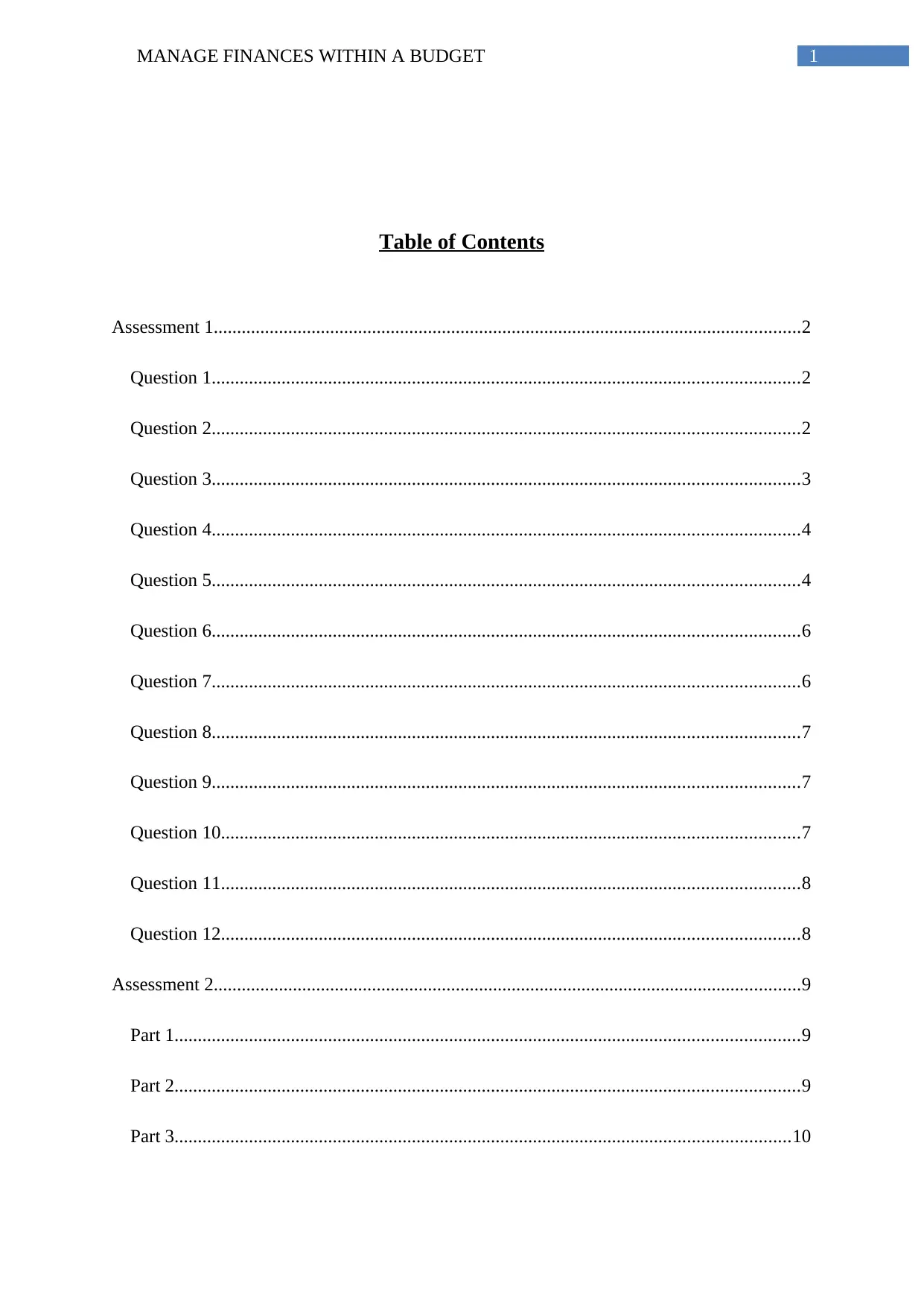
1MANAGE FINANCES WITHIN A BUDGET
Table of Contents
Assessment 1..............................................................................................................................2
Question 1..............................................................................................................................2
Question 2..............................................................................................................................2
Question 3..............................................................................................................................3
Question 4..............................................................................................................................4
Question 5..............................................................................................................................4
Question 6..............................................................................................................................6
Question 7..............................................................................................................................6
Question 8..............................................................................................................................7
Question 9..............................................................................................................................7
Question 10............................................................................................................................7
Question 11............................................................................................................................8
Question 12............................................................................................................................8
Assessment 2..............................................................................................................................9
Part 1......................................................................................................................................9
Part 2......................................................................................................................................9
Part 3....................................................................................................................................10
Table of Contents
Assessment 1..............................................................................................................................2
Question 1..............................................................................................................................2
Question 2..............................................................................................................................2
Question 3..............................................................................................................................3
Question 4..............................................................................................................................4
Question 5..............................................................................................................................4
Question 6..............................................................................................................................6
Question 7..............................................................................................................................6
Question 8..............................................................................................................................7
Question 9..............................................................................................................................7
Question 10............................................................................................................................7
Question 11............................................................................................................................8
Question 12............................................................................................................................8
Assessment 2..............................................................................................................................9
Part 1......................................................................................................................................9
Part 2......................................................................................................................................9
Part 3....................................................................................................................................10
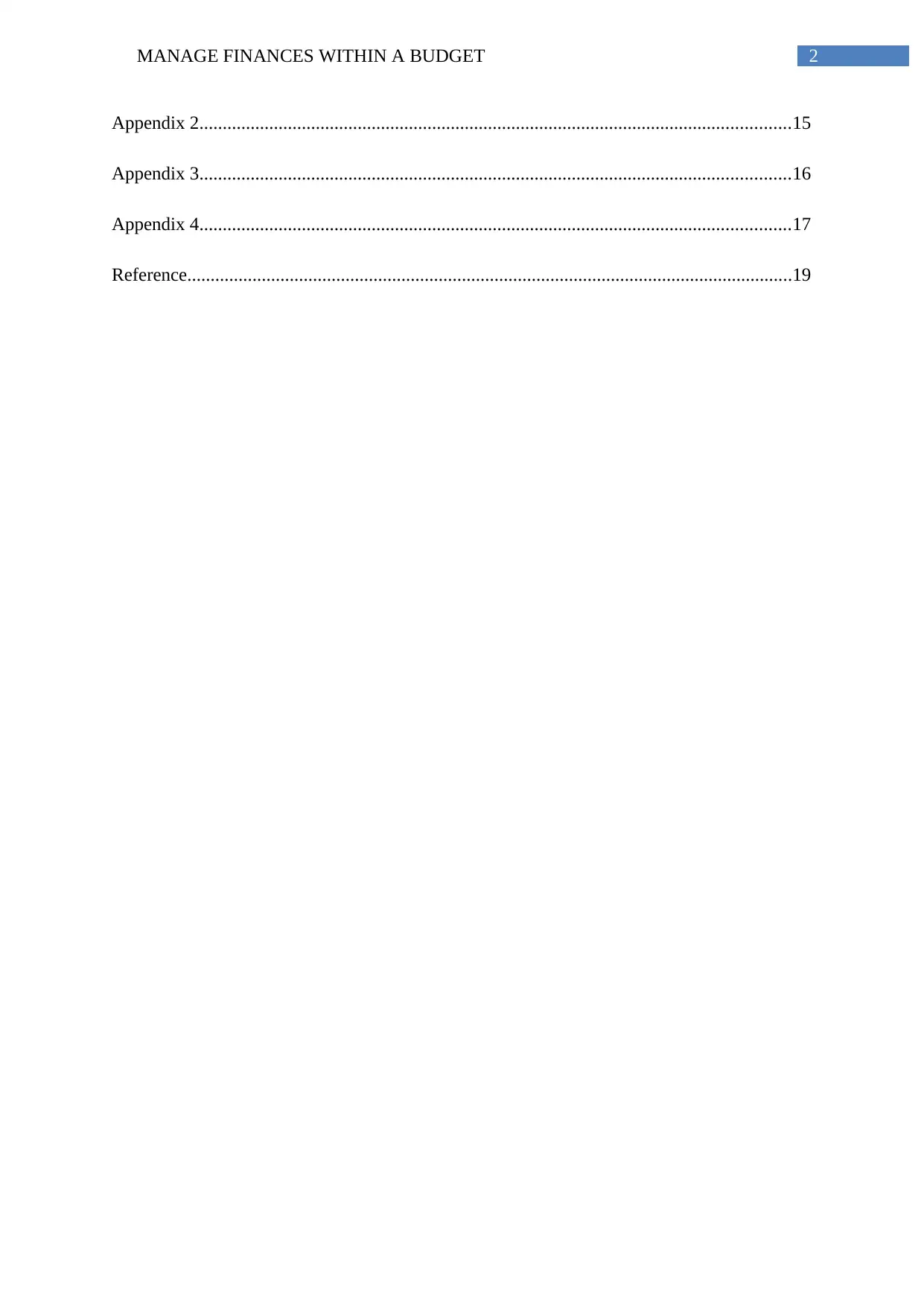
2MANAGE FINANCES WITHIN A BUDGET
Appendix 2...............................................................................................................................15
Appendix 3...............................................................................................................................16
Appendix 4...............................................................................................................................17
Reference..................................................................................................................................19
Appendix 2...............................................................................................................................15
Appendix 3...............................................................................................................................16
Appendix 4...............................................................................................................................17
Reference..................................................................................................................................19
⊘ This is a preview!⊘
Do you want full access?
Subscribe today to unlock all pages.

Trusted by 1+ million students worldwide

3MANAGE FINANCES WITHIN A BUDGET
Assessment 1
Question 1
8 different types of financial records are –
General account books.
Cash book records
Banking records
Creditors’ records
Debtors’ records
Details of any contracts
Tax invoices and other relevant tax records
Stock records
Question 2
If the business is registered for GST it shall lodge a business activity statement
(BAS). Components of BAS are –
Goods and services tax (GST)*
Pay as you go (PAYG) income tax instalment*
Pay as you go (PAYG) tax withheld.
Fringe benefits tax (FBT) instalment.
Luxury car tax (LCT)
Wine equalisation tax (WET)
Assessment 1
Question 1
8 different types of financial records are –
General account books.
Cash book records
Banking records
Creditors’ records
Debtors’ records
Details of any contracts
Tax invoices and other relevant tax records
Stock records
Question 2
If the business is registered for GST it shall lodge a business activity statement
(BAS). Components of BAS are –
Goods and services tax (GST)*
Pay as you go (PAYG) income tax instalment*
Pay as you go (PAYG) tax withheld.
Fringe benefits tax (FBT) instalment.
Luxury car tax (LCT)
Wine equalisation tax (WET)
Paraphrase This Document
Need a fresh take? Get an instant paraphrase of this document with our AI Paraphraser
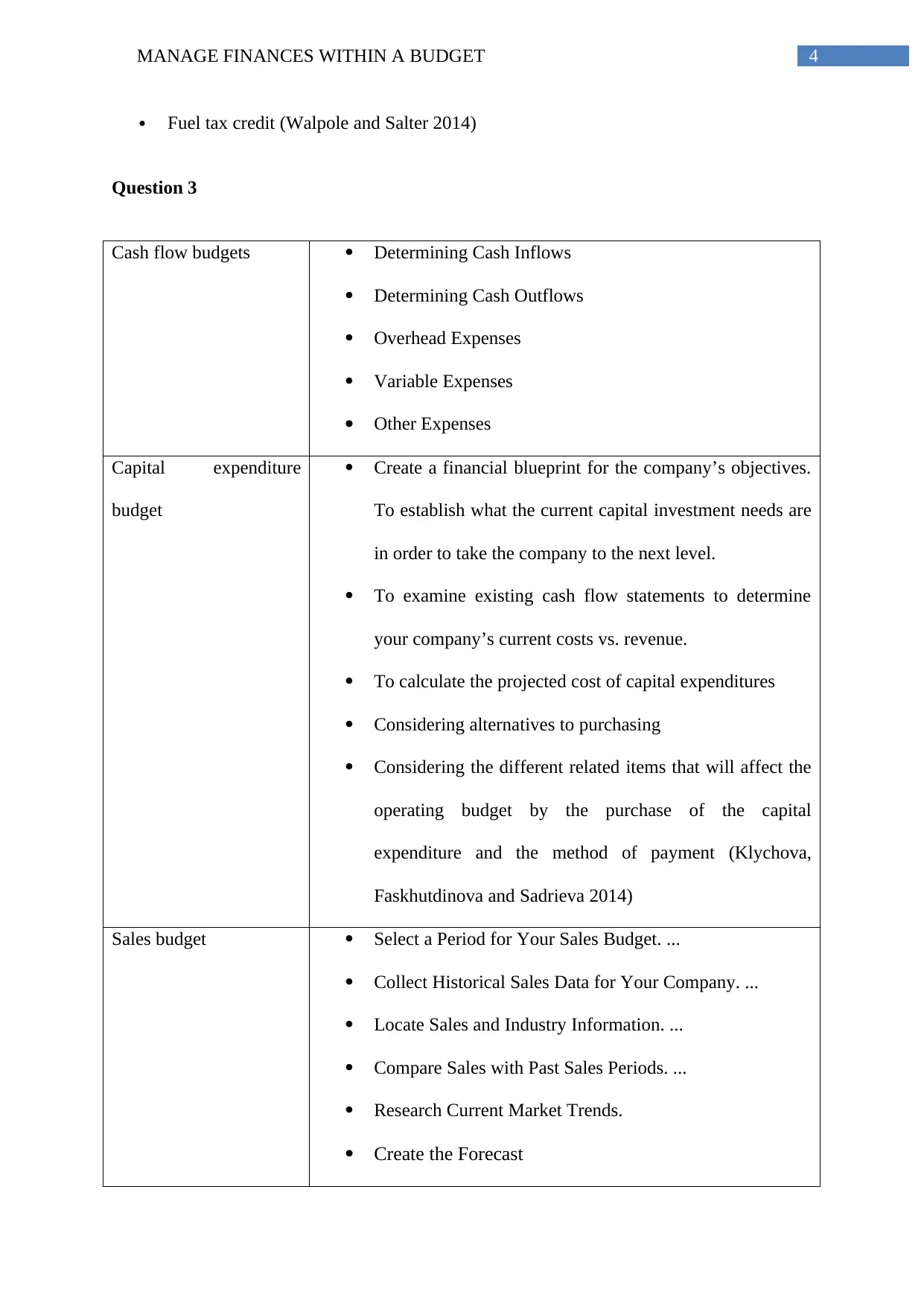
4MANAGE FINANCES WITHIN A BUDGET
Fuel tax credit (Walpole and Salter 2014)
Question 3
Cash flow budgets Determining Cash Inflows
Determining Cash Outflows
Overhead Expenses
Variable Expenses
Other Expenses
Capital expenditure
budget
Create a financial blueprint for the company’s objectives.
To establish what the current capital investment needs are
in order to take the company to the next level.
To examine existing cash flow statements to determine
your company’s current costs vs. revenue.
To calculate the projected cost of capital expenditures
Considering alternatives to purchasing
Considering the different related items that will affect the
operating budget by the purchase of the capital
expenditure and the method of payment (Klychova,
Faskhutdinova and Sadrieva 2014)
Sales budget Select a Period for Your Sales Budget. ...
Collect Historical Sales Data for Your Company. ...
Locate Sales and Industry Information. ...
Compare Sales with Past Sales Periods. ...
Research Current Market Trends.
Create the Forecast
Fuel tax credit (Walpole and Salter 2014)
Question 3
Cash flow budgets Determining Cash Inflows
Determining Cash Outflows
Overhead Expenses
Variable Expenses
Other Expenses
Capital expenditure
budget
Create a financial blueprint for the company’s objectives.
To establish what the current capital investment needs are
in order to take the company to the next level.
To examine existing cash flow statements to determine
your company’s current costs vs. revenue.
To calculate the projected cost of capital expenditures
Considering alternatives to purchasing
Considering the different related items that will affect the
operating budget by the purchase of the capital
expenditure and the method of payment (Klychova,
Faskhutdinova and Sadrieva 2014)
Sales budget Select a Period for Your Sales Budget. ...
Collect Historical Sales Data for Your Company. ...
Locate Sales and Industry Information. ...
Compare Sales with Past Sales Periods. ...
Research Current Market Trends.
Create the Forecast
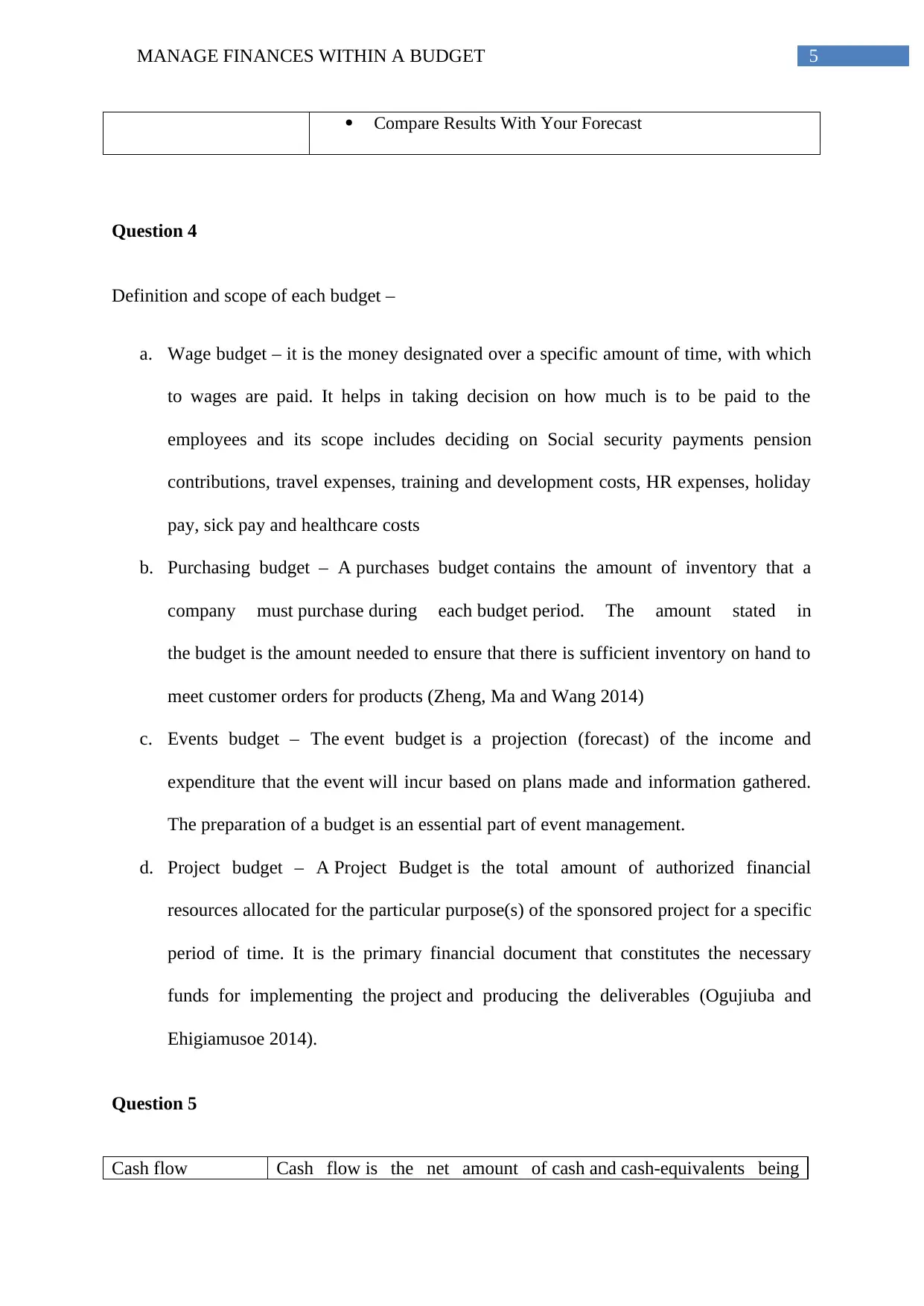
5MANAGE FINANCES WITHIN A BUDGET
Compare Results With Your Forecast
Question 4
Definition and scope of each budget –
a. Wage budget – it is the money designated over a specific amount of time, with which
to wages are paid. It helps in taking decision on how much is to be paid to the
employees and its scope includes deciding on Social security payments pension
contributions, travel expenses, training and development costs, HR expenses, holiday
pay, sick pay and healthcare costs
b. Purchasing budget – A purchases budget contains the amount of inventory that a
company must purchase during each budget period. The amount stated in
the budget is the amount needed to ensure that there is sufficient inventory on hand to
meet customer orders for products (Zheng, Ma and Wang 2014)
c. Events budget – The event budget is a projection (forecast) of the income and
expenditure that the event will incur based on plans made and information gathered.
The preparation of a budget is an essential part of event management.
d. Project budget – A Project Budget is the total amount of authorized financial
resources allocated for the particular purpose(s) of the sponsored project for a specific
period of time. It is the primary financial document that constitutes the necessary
funds for implementing the project and producing the deliverables (Ogujiuba and
Ehigiamusoe 2014).
Question 5
Cash flow Cash flow is the net amount of cash and cash-equivalents being
Compare Results With Your Forecast
Question 4
Definition and scope of each budget –
a. Wage budget – it is the money designated over a specific amount of time, with which
to wages are paid. It helps in taking decision on how much is to be paid to the
employees and its scope includes deciding on Social security payments pension
contributions, travel expenses, training and development costs, HR expenses, holiday
pay, sick pay and healthcare costs
b. Purchasing budget – A purchases budget contains the amount of inventory that a
company must purchase during each budget period. The amount stated in
the budget is the amount needed to ensure that there is sufficient inventory on hand to
meet customer orders for products (Zheng, Ma and Wang 2014)
c. Events budget – The event budget is a projection (forecast) of the income and
expenditure that the event will incur based on plans made and information gathered.
The preparation of a budget is an essential part of event management.
d. Project budget – A Project Budget is the total amount of authorized financial
resources allocated for the particular purpose(s) of the sponsored project for a specific
period of time. It is the primary financial document that constitutes the necessary
funds for implementing the project and producing the deliverables (Ogujiuba and
Ehigiamusoe 2014).
Question 5
Cash flow Cash flow is the net amount of cash and cash-equivalents being
⊘ This is a preview!⊘
Do you want full access?
Subscribe today to unlock all pages.

Trusted by 1+ million students worldwide
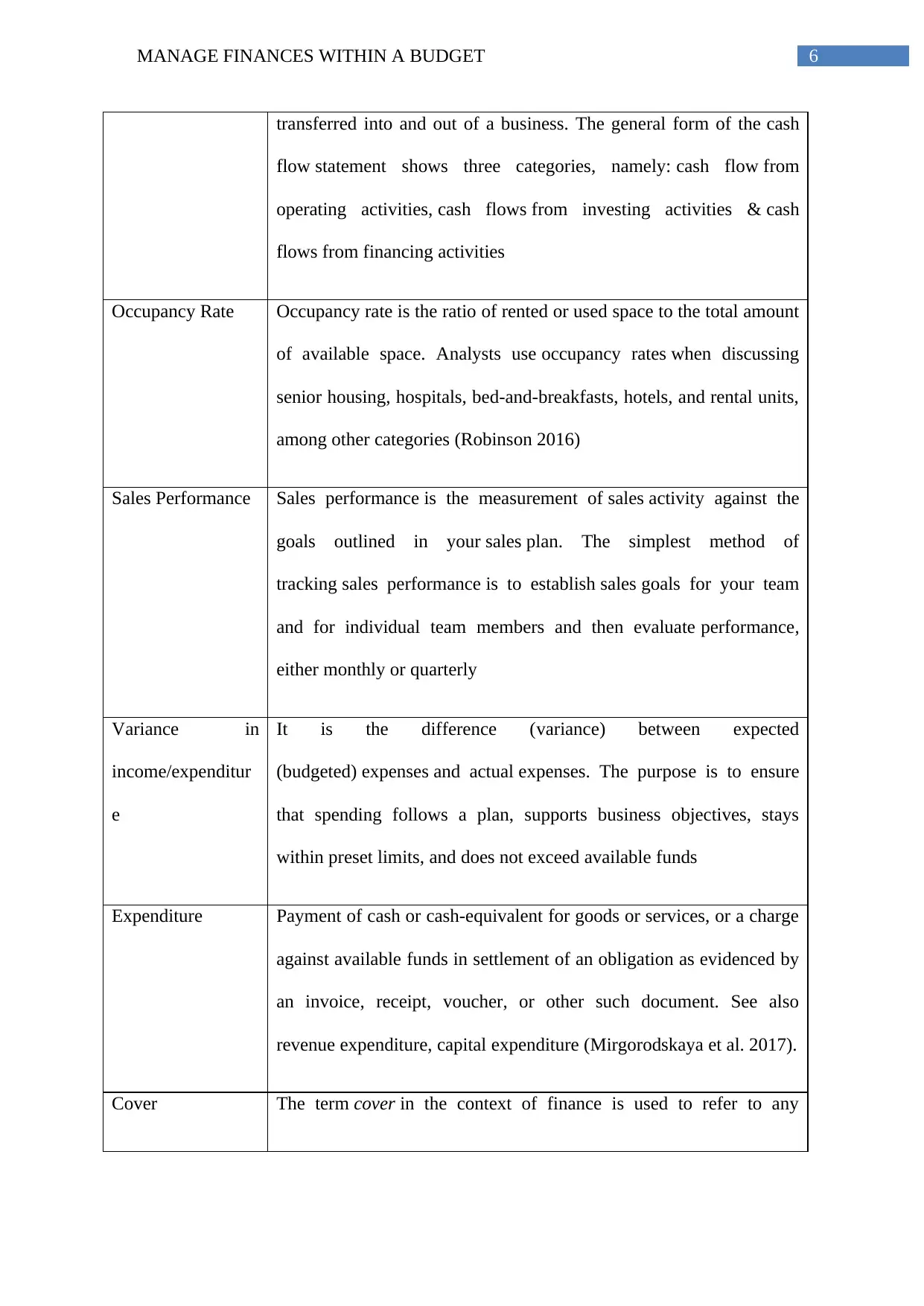
6MANAGE FINANCES WITHIN A BUDGET
transferred into and out of a business. The general form of the cash
flow statement shows three categories, namely: cash flow from
operating activities, cash flows from investing activities & cash
flows from financing activities
Occupancy Rate Occupancy rate is the ratio of rented or used space to the total amount
of available space. Analysts use occupancy rates when discussing
senior housing, hospitals, bed-and-breakfasts, hotels, and rental units,
among other categories (Robinson 2016)
Sales Performance Sales performance is the measurement of sales activity against the
goals outlined in your sales plan. The simplest method of
tracking sales performance is to establish sales goals for your team
and for individual team members and then evaluate performance,
either monthly or quarterly
Variance in
income/expenditur
e
It is the difference (variance) between expected
(budgeted) expenses and actual expenses. The purpose is to ensure
that spending follows a plan, supports business objectives, stays
within preset limits, and does not exceed available funds
Expenditure Payment of cash or cash-equivalent for goods or services, or a charge
against available funds in settlement of an obligation as evidenced by
an invoice, receipt, voucher, or other such document. See also
revenue expenditure, capital expenditure (Mirgorodskaya et al. 2017).
Cover The term cover in the context of finance is used to refer to any
transferred into and out of a business. The general form of the cash
flow statement shows three categories, namely: cash flow from
operating activities, cash flows from investing activities & cash
flows from financing activities
Occupancy Rate Occupancy rate is the ratio of rented or used space to the total amount
of available space. Analysts use occupancy rates when discussing
senior housing, hospitals, bed-and-breakfasts, hotels, and rental units,
among other categories (Robinson 2016)
Sales Performance Sales performance is the measurement of sales activity against the
goals outlined in your sales plan. The simplest method of
tracking sales performance is to establish sales goals for your team
and for individual team members and then evaluate performance,
either monthly or quarterly
Variance in
income/expenditur
e
It is the difference (variance) between expected
(budgeted) expenses and actual expenses. The purpose is to ensure
that spending follows a plan, supports business objectives, stays
within preset limits, and does not exceed available funds
Expenditure Payment of cash or cash-equivalent for goods or services, or a charge
against available funds in settlement of an obligation as evidenced by
an invoice, receipt, voucher, or other such document. See also
revenue expenditure, capital expenditure (Mirgorodskaya et al. 2017).
Cover The term cover in the context of finance is used to refer to any
Paraphrase This Document
Need a fresh take? Get an instant paraphrase of this document with our AI Paraphraser
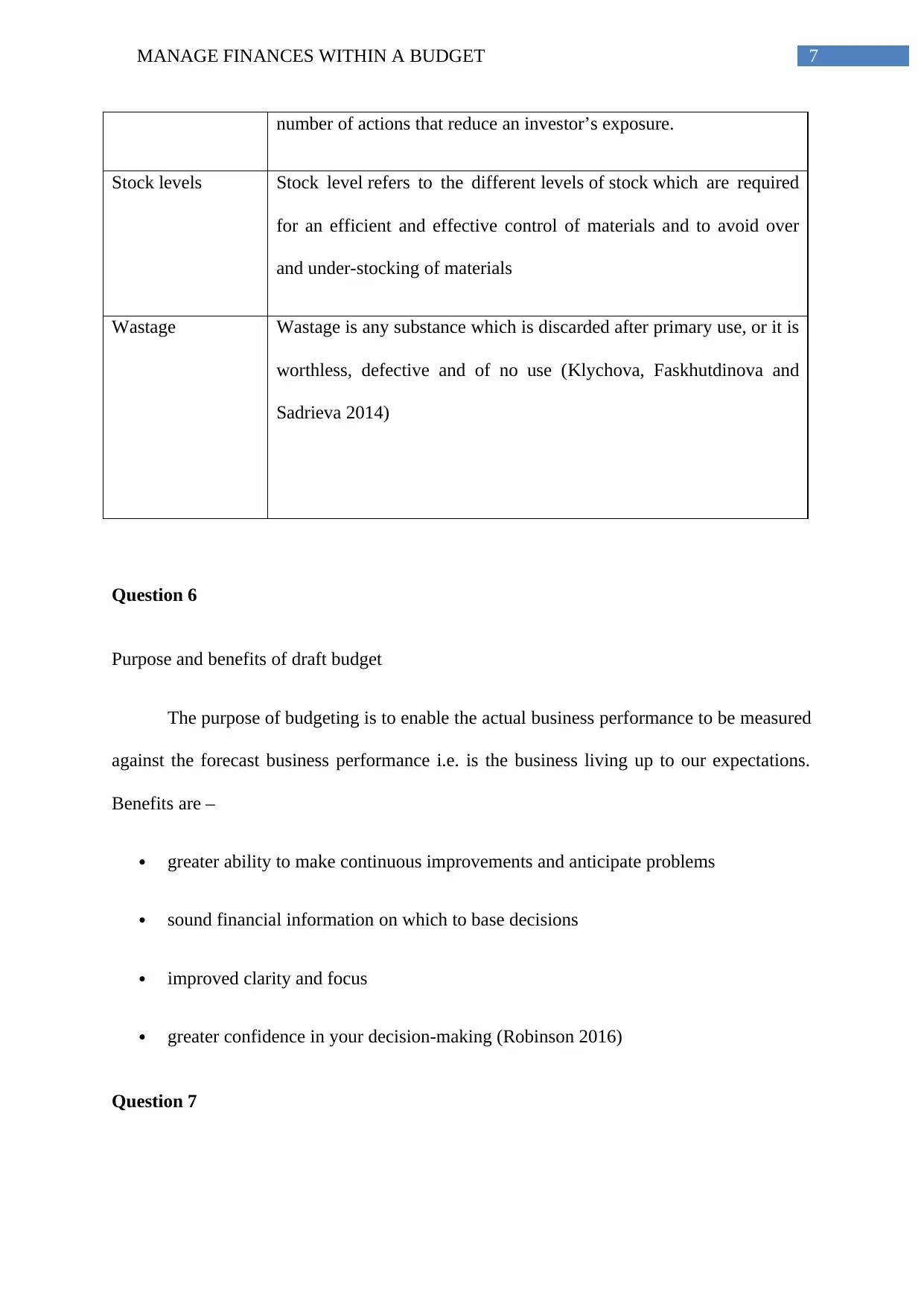
7MANAGE FINANCES WITHIN A BUDGET
number of actions that reduce an investor’s exposure.
Stock levels Stock level refers to the different levels of stock which are required
for an efficient and effective control of materials and to avoid over
and under-stocking of materials
Wastage Wastage is any substance which is discarded after primary use, or it is
worthless, defective and of no use (Klychova, Faskhutdinova and
Sadrieva 2014)
Question 6
Purpose and benefits of draft budget
The purpose of budgeting is to enable the actual business performance to be measured
against the forecast business performance i.e. is the business living up to our expectations.
Benefits are –
greater ability to make continuous improvements and anticipate problems
sound financial information on which to base decisions
improved clarity and focus
greater confidence in your decision-making (Robinson 2016)
Question 7
number of actions that reduce an investor’s exposure.
Stock levels Stock level refers to the different levels of stock which are required
for an efficient and effective control of materials and to avoid over
and under-stocking of materials
Wastage Wastage is any substance which is discarded after primary use, or it is
worthless, defective and of no use (Klychova, Faskhutdinova and
Sadrieva 2014)
Question 6
Purpose and benefits of draft budget
The purpose of budgeting is to enable the actual business performance to be measured
against the forecast business performance i.e. is the business living up to our expectations.
Benefits are –
greater ability to make continuous improvements and anticipate problems
sound financial information on which to base decisions
improved clarity and focus
greater confidence in your decision-making (Robinson 2016)
Question 7

8MANAGE FINANCES WITHIN A BUDGET
Every revenue and expenses items of budget shall be compared with actual amount of
revenues and expenses.
Question 8
When preparing a budget it is important to include all relevant components
(operating, financial and capital expenditure budget), correct techniques for estimation and
provide supporting documentation shall be used.
Question 9
Main components of operating budget are –
Sales Budget
Production Budget
Direct Materials Purchases Budget.
Direct Labour Budget
Overhead Budget
Question 10
Variance A budget variance is the difference between the budgeted or
baseline amount of expense or revenue, and the actual amount
Projected/Forecasted
Figure
Forecast states its actual expectations for results, usually in a
much more summarized format
Actual Figure actual figures reflect how much revenue an account has
actually generated or how much money an account has paid out
Every revenue and expenses items of budget shall be compared with actual amount of
revenues and expenses.
Question 8
When preparing a budget it is important to include all relevant components
(operating, financial and capital expenditure budget), correct techniques for estimation and
provide supporting documentation shall be used.
Question 9
Main components of operating budget are –
Sales Budget
Production Budget
Direct Materials Purchases Budget.
Direct Labour Budget
Overhead Budget
Question 10
Variance A budget variance is the difference between the budgeted or
baseline amount of expense or revenue, and the actual amount
Projected/Forecasted
Figure
Forecast states its actual expectations for results, usually in a
much more summarized format
Actual Figure actual figures reflect how much revenue an account has
actually generated or how much money an account has paid out
⊘ This is a preview!⊘
Do you want full access?
Subscribe today to unlock all pages.

Trusted by 1+ million students worldwide
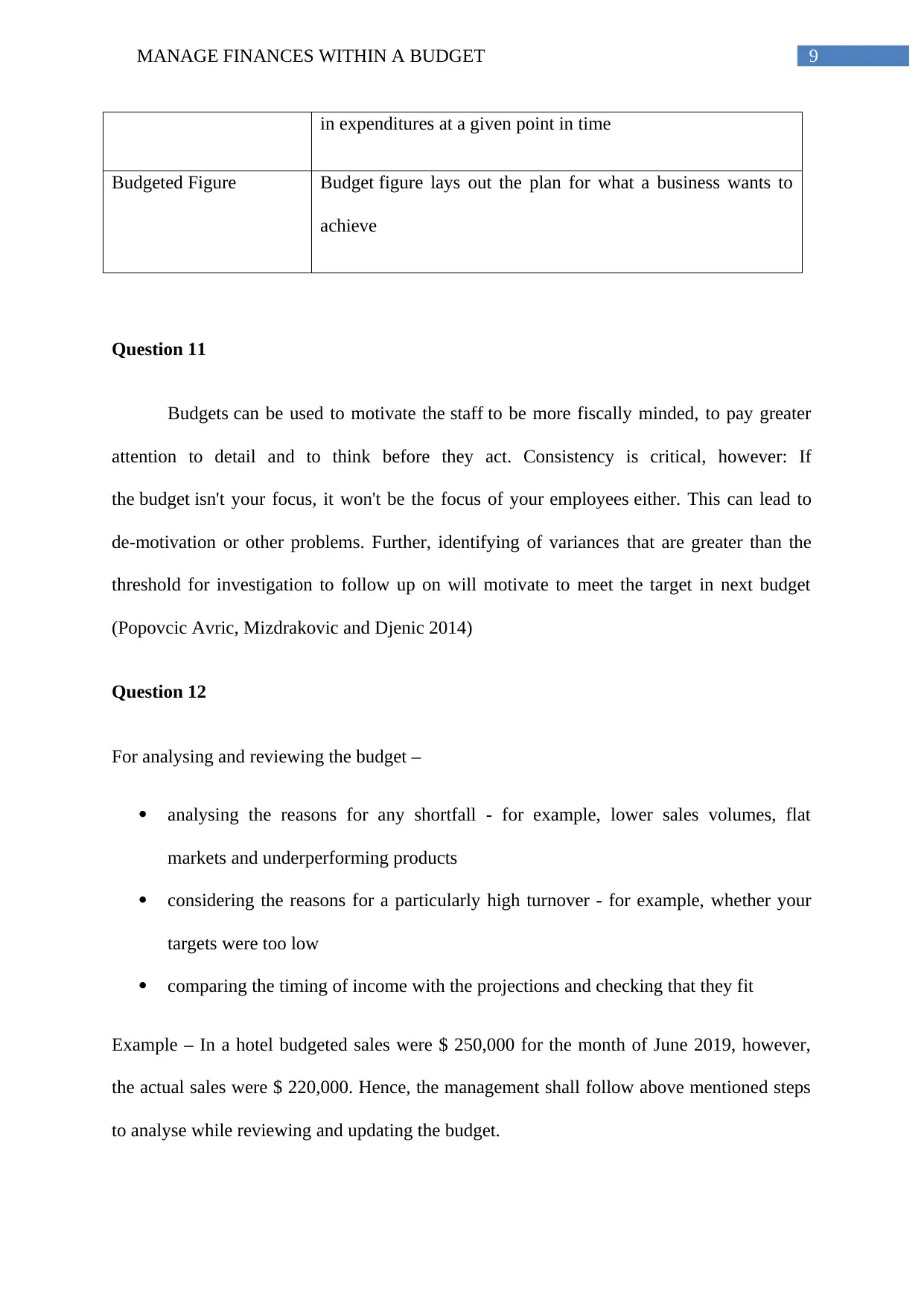
9MANAGE FINANCES WITHIN A BUDGET
in expenditures at a given point in time
Budgeted Figure Budget figure lays out the plan for what a business wants to
achieve
Question 11
Budgets can be used to motivate the staff to be more fiscally minded, to pay greater
attention to detail and to think before they act. Consistency is critical, however: If
the budget isn't your focus, it won't be the focus of your employees either. This can lead to
de-motivation or other problems. Further, identifying of variances that are greater than the
threshold for investigation to follow up on will motivate to meet the target in next budget
(Popovcic Avric, Mizdrakovic and Djenic 2014)
Question 12
For analysing and reviewing the budget –
analysing the reasons for any shortfall - for example, lower sales volumes, flat
markets and underperforming products
considering the reasons for a particularly high turnover - for example, whether your
targets were too low
comparing the timing of income with the projections and checking that they fit
Example – In a hotel budgeted sales were $ 250,000 for the month of June 2019, however,
the actual sales were $ 220,000. Hence, the management shall follow above mentioned steps
to analyse while reviewing and updating the budget.
in expenditures at a given point in time
Budgeted Figure Budget figure lays out the plan for what a business wants to
achieve
Question 11
Budgets can be used to motivate the staff to be more fiscally minded, to pay greater
attention to detail and to think before they act. Consistency is critical, however: If
the budget isn't your focus, it won't be the focus of your employees either. This can lead to
de-motivation or other problems. Further, identifying of variances that are greater than the
threshold for investigation to follow up on will motivate to meet the target in next budget
(Popovcic Avric, Mizdrakovic and Djenic 2014)
Question 12
For analysing and reviewing the budget –
analysing the reasons for any shortfall - for example, lower sales volumes, flat
markets and underperforming products
considering the reasons for a particularly high turnover - for example, whether your
targets were too low
comparing the timing of income with the projections and checking that they fit
Example – In a hotel budgeted sales were $ 250,000 for the month of June 2019, however,
the actual sales were $ 220,000. Hence, the management shall follow above mentioned steps
to analyse while reviewing and updating the budget.
Paraphrase This Document
Need a fresh take? Get an instant paraphrase of this document with our AI Paraphraser
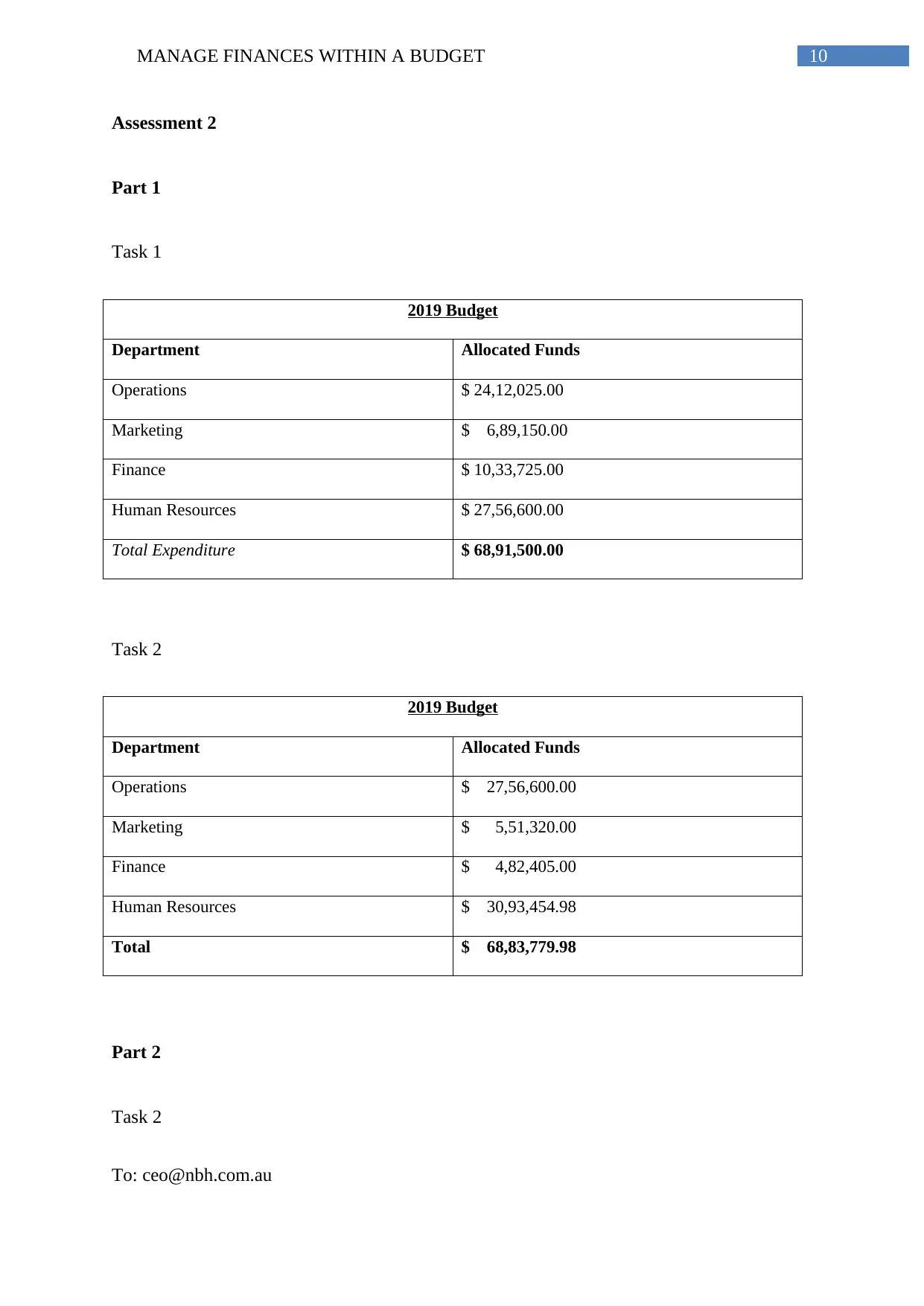
10MANAGE FINANCES WITHIN A BUDGET
Assessment 2
Part 1
Task 1
2019 Budget
Department Allocated Funds
Operations $ 24,12,025.00
Marketing $ 6,89,150.00
Finance $ 10,33,725.00
Human Resources $ 27,56,600.00
Total Expenditure $ 68,91,500.00
Task 2
2019 Budget
Department Allocated Funds
Operations $ 27,56,600.00
Marketing $ 5,51,320.00
Finance $ 4,82,405.00
Human Resources $ 30,93,454.98
Total $ 68,83,779.98
Part 2
Task 2
To: ceo@nbh.com.au
Assessment 2
Part 1
Task 1
2019 Budget
Department Allocated Funds
Operations $ 24,12,025.00
Marketing $ 6,89,150.00
Finance $ 10,33,725.00
Human Resources $ 27,56,600.00
Total Expenditure $ 68,91,500.00
Task 2
2019 Budget
Department Allocated Funds
Operations $ 27,56,600.00
Marketing $ 5,51,320.00
Finance $ 4,82,405.00
Human Resources $ 30,93,454.98
Total $ 68,83,779.98
Part 2
Task 2
To: ceo@nbh.com.au
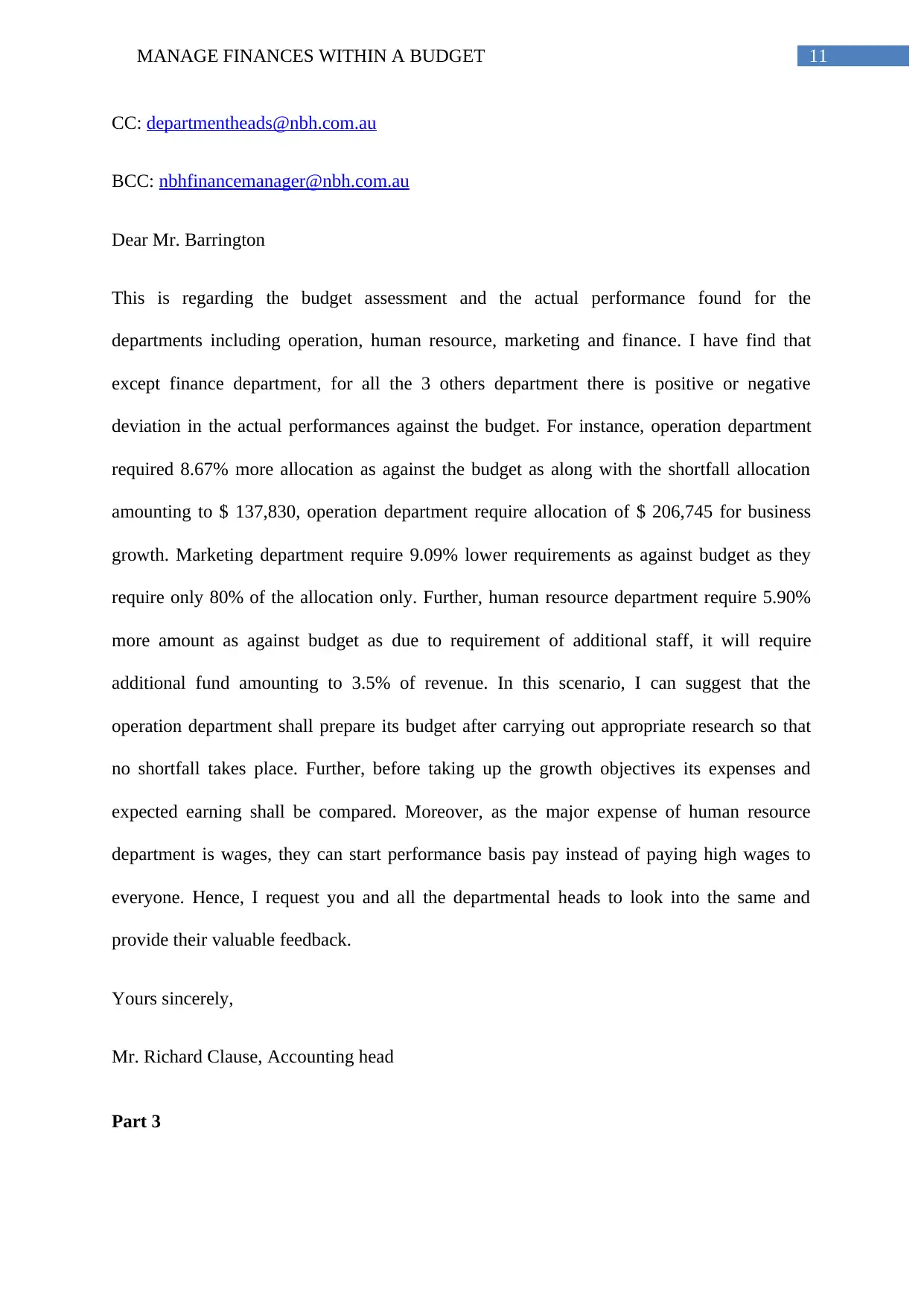
11MANAGE FINANCES WITHIN A BUDGET
CC: departmentheads@nbh.com.au
BCC: nbhfinancemanager@nbh.com.au
Dear Mr. Barrington
This is regarding the budget assessment and the actual performance found for the
departments including operation, human resource, marketing and finance. I have find that
except finance department, for all the 3 others department there is positive or negative
deviation in the actual performances against the budget. For instance, operation department
required 8.67% more allocation as against the budget as along with the shortfall allocation
amounting to $ 137,830, operation department require allocation of $ 206,745 for business
growth. Marketing department require 9.09% lower requirements as against budget as they
require only 80% of the allocation only. Further, human resource department require 5.90%
more amount as against budget as due to requirement of additional staff, it will require
additional fund amounting to 3.5% of revenue. In this scenario, I can suggest that the
operation department shall prepare its budget after carrying out appropriate research so that
no shortfall takes place. Further, before taking up the growth objectives its expenses and
expected earning shall be compared. Moreover, as the major expense of human resource
department is wages, they can start performance basis pay instead of paying high wages to
everyone. Hence, I request you and all the departmental heads to look into the same and
provide their valuable feedback.
Yours sincerely,
Mr. Richard Clause, Accounting head
Part 3
CC: departmentheads@nbh.com.au
BCC: nbhfinancemanager@nbh.com.au
Dear Mr. Barrington
This is regarding the budget assessment and the actual performance found for the
departments including operation, human resource, marketing and finance. I have find that
except finance department, for all the 3 others department there is positive or negative
deviation in the actual performances against the budget. For instance, operation department
required 8.67% more allocation as against the budget as along with the shortfall allocation
amounting to $ 137,830, operation department require allocation of $ 206,745 for business
growth. Marketing department require 9.09% lower requirements as against budget as they
require only 80% of the allocation only. Further, human resource department require 5.90%
more amount as against budget as due to requirement of additional staff, it will require
additional fund amounting to 3.5% of revenue. In this scenario, I can suggest that the
operation department shall prepare its budget after carrying out appropriate research so that
no shortfall takes place. Further, before taking up the growth objectives its expenses and
expected earning shall be compared. Moreover, as the major expense of human resource
department is wages, they can start performance basis pay instead of paying high wages to
everyone. Hence, I request you and all the departmental heads to look into the same and
provide their valuable feedback.
Yours sincerely,
Mr. Richard Clause, Accounting head
Part 3
⊘ This is a preview!⊘
Do you want full access?
Subscribe today to unlock all pages.

Trusted by 1+ million students worldwide
1 out of 21
Related Documents
Your All-in-One AI-Powered Toolkit for Academic Success.
+13062052269
info@desklib.com
Available 24*7 on WhatsApp / Email
![[object Object]](/_next/static/media/star-bottom.7253800d.svg)
Unlock your academic potential
Copyright © 2020–2025 A2Z Services. All Rights Reserved. Developed and managed by ZUCOL.




